Home | Front Page | Index | Blog | New | Contact | Site Map
Lake Peten Itza
Tikal
Coban
Guatemala City
Lake Atitlan
Markets
Antigua
Rio Dulce
Esquipulas
Mundo Maya
Foto Show

Central America
Route Maps
Belize
Honduras
Nicaragua
Costa Rica
Panama
Mexico 2003-04:
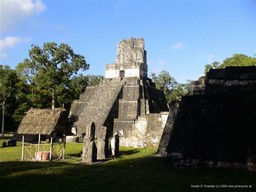
Tikal |
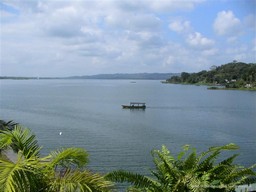
Lake Peten Itza |
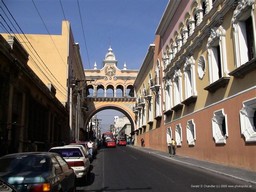
Guatemala City |

Lake Atitlan |
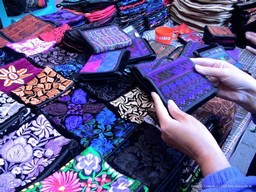
Chichicastenango |
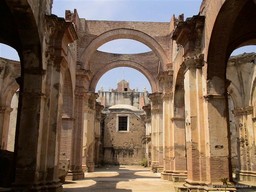
Antigua Guatemala |
Guatemala has greatly surprised us, perhaps even more than Mexico. When we were in Mexico we were so busy learning about it that we had no place in our mind for investigating Guatemala. From the newspapers and other travelers we got conflicting ideas about the country. Newspapers emphasized the negative: the danger, the crime, the poverty. Travelers emphasized the positive: the color, the people, the handicrafts. In short, we came down on the positive side. If we tell you that our greatest disappointment was that the closest we ever got to the national bird of Guatemala, the quetzal, was its picture on the notes of the national currency of the same name, you will understand perhaps the level of our enjoyment here.
We rather assumed that since it was in the tropics, it would be — well, would you believe it — tropical. It is that in some places, particularly the north, but mostly it is not. There are mountains, lots of them, sometimes green with pine forests and sometimes brown because of the stubble of corn or just because the dry "summer" (late February) has come. In the long Montagua valley, for example, in just two hundred kilometers the terrain descends from an altitude of 1500 meters to sea level and changes from neither cool nor warm to hot, near desert (with some cactus), then to green pastures, and finally to lowland tropical coverage.
The surprises have been in the people and the politics too. Again, for our nearly six months in Mexico it and the USA seemed to make up the universe of the local papers, with hardly more than a Mideast bombing or two to distract from home affairs. In Guatemala, with little surprise, their government (and the USA and a bit of Mexico and the rest of Latin America) make up the universe of interest. We learned that Oscar Berger is the new president, elected in November, 2003 and that most of the former government (according to his government) was corrupt. In our few weeks here we saw former and current high official after high official flee the law by crossing the border in the middle of the night to Nicaragua or in broad daylight fly away to Miami. The front pages of the tabloids (all the papers here seem to be published in tabloid format) filled with headlines about it and sometimes photos of the returned in orange prison garb.
Another political surprise is the leftover of the 35-year old civil war. The peace, now seven years old, has not yet completely taken root in that almost every business of any size has an armed guard, just in case. For instance, we went to a pharmacy after dark to buy some aspirin and found an armed guard outside. For supper one evening we went into a chain restaurant on the edge of the Plaza Mayor in Guatemala City and the door was opened by an armed guard.
From personal experience and from the papers we have learned about the rapid economic changes. In the last ten years the proportion of the population with electricity has gone from 40% to 80%. There are cell phone users in the streets everywhere. Cellphones are often a tool of business: our driver to Ceibal and our boat pilot on the Rio Dulce both had them; from their salaries it seems impossible that they could personally afford them. Highways that our guidebook describes as being unpaved and requiring a bumpy 7-12 hour bus ride are now paved and we rolled smoothly along them in 1/3 of the described time. For example, on our way to Coban we drove in two hours a stretch that an old guide says requires twelve hours in a four-wheel drive.
About 50-60% of the people of Guatemala are of indigenous stock, mostly offshoots of Mayans. Until just a few years ago many of them (perhaps a majority), mostly the isolated ones, wore traditional, hand made clothes. Now if you are in the right place — the western highlands and tourist oriented markets, you will see these colorful huipils and skirts, made by hand on backstrap looms. But mostly it is adult women and very old men who wear traditional garb. Almost all men wear western clothes, often jeans with a broad brimmed straw cowboy hat. Little girls wear frilly dresses and/or jeans as do many teenagers. These changes obviously have been the fruits of technology: electricity brings television and that brings fashion ideas. Highways bring travel and that brings fashion ideas and new foods. But the UN and other non-profits have taught the indigenous peoples how to convert their traditional clothing and handicraft skills into ways to make money. That means that there is a wide variety of handicrafts for sale at very good prices with a varying level of quality, of course.
There seem to be many more links, relative to its size, between Guatemala and the United States, than between Mexico and the United States. We guess that it is because Mexico is so close to the United States that it, or its cultural leaders, push it away when they can. And furthermore, Mexico is big enough to have its own everything — large newspapers, entertainment giants, research universities, etc. Guatemala must, because of its relatively small population of twelve million, turn to the external world; very often, it seems, that is the United States. It is only a two hour flight from Guatemala City to Houston (1750 km) or Miami (1650 m), not really much more time, when check-ins, etc are considered, than to Mexico City (1100 km). Among the similarities we especially liked is the food: much less fried stuff and beans and tortillas and much more availability of salads.
The noise of Guatemalan hotel/motels cannot be passed over. Many have a central courtyard and the result is that any noise, from anywhere, reverberates. And, because of the fine climate, most have louvered glass windows that let in lots of air, which is nice; but because they often don't close well, they also let in whatever noise may be around. That is fine for birds but not car engines. In what was otherwise our quiet place in Coban (and Copan, too, but that is in Honduras) and even upper scale Antigua the central court was used as an overnight parking lot. Every evening there was a racket as it filled and at dawn the next day a similar racket as it emptied. And these were largely pickups whose operators initially gunned the engine and then let it rumble and rumble. This may not apply to more luxurious accommodations, but it is what we experienced.
Our Route

The map shows our route through Belize and Guatemala to Copan and Gracias in Honduras. Sites marked with a green dot are places we stayed; blue dots show places we made day trips to.
We entered Guatemala in the northeast after 18 days in Belize. We drove west over rough roads and spent two nights on the eastern end of Laken Peter Itzen. From there we went west to Flores for five nights on the western end. To get south and west we had a choice between going via Rio Dulce or Coban. We were assured the road via Coban was good, in fact, newly built, so we opted for that. Two nights in Coban and then we were off for Guatemala City. Most tourists give it a miss but we — or at least Gerry — were happy to see it. Then west. We bypassed the nearer Antigua to go to Lake Atitlan. That we made the base for excursions across the lake, to Solola, and to Chichicastenango. Then on to Antigua. From there we went indirectly to Rio Dulce by going over the shoulder of the volcano to the southern side and then passing through without stopping in Guatemala City. In Rio Dulce we were so close to Tikal that we thought of going back for a second look. But the visa clock was ticking and instead we went for a night in Esquipulas and then on to Honduras via El Florido.
Central America on a Shoestring
Perhaps this is a good place to comment on our Lonely Planet guide. Since we left Mexico, we have been using the LP guide to Central America. Other people we have met have a smaller guide dedicated to Guatemala, which has more detail than ours which we regret. Our version is also called "On a Shoestring", which means that mid-range hotels are often excised when space needs to be saved. And last, but not least, the information in the book is now four years old which means that hotels have closed, prices have changed, and so on. It is better than nothing, but could be improved on quite a bit. We had not found the individual guides for any Central American countries when we bought our book and anyway it took lots of time to convince Gerry that it was worth buying it ahead of time as he was convinced we would find it on site. We tried that in Turkey and found ourselves without a guide book for more than half of our time in that country.